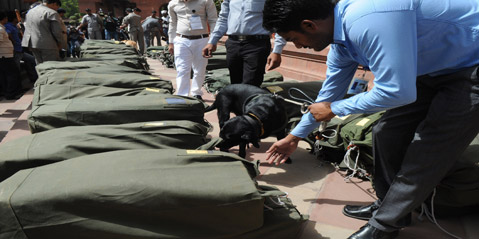Union Budget 2015-16 presented by India’s Finance Minister Arun Jaitley on February 28, which was keenly awaited to see the evolution of a clearer fiscal and socioeconomic policy initiatives, seems to have met India Inc’s approval, going by the stock market barometer, Sensex. Notwithstanding the high volatility on budget day, the pivotal scrip price index ended on a positive note in the three post-budget trading sessions (including that on budget day).
Due to reduced fiscal space as a result of a sharp 10 percentage points hike in tax devolution to states, on the basis of the recommendation of the 14th Finance Commission on one hand and the need for stepped-up allocation for public sector capital expenditure in infrastructure sectors to entice private sector capex on the other, the finance minister has done well to defer FRBM (Fiscal Responsibility and Budget Management) targets by one year.
The finance minister has also come up with a fair dose of proposals including those on improvement in governance, laying a medium-term roadmap for corporate tax structure and capex facilitators to rekindle private sector investment interest. RBI has supported these measures by announcing, on March 4, a 25 bps reduction in short-term repo policy rate to 7.5 per cent.
Interestingly, even as disbursements are given by plan and non-plan classification as usual, there is no mention in the budget about the 12th Plan which would be into its fourth year in 2015-16. India’s apex planning body, the Planning Commission, has already been replaced by Niti Ayog, which will have a much broader canvas in the country’s development process.
Budget numbers
Gross fiscal deficit, or net borrowing to bridge the gap between disbursement and non-debt receipt, would rise 8.4 per cent, four times 1.9 per cent during 2014-15 and it would be 3.9 per cent (4.1 per cent) of GDPmp for the year. Extra fiscal space due to deficit escalation is proposed to fund public sector capital expenditure, particularly infrastructure capex.
Direct tax proposals are expected to result in a loss of Rs.8,315 crore, but indirect tax proposals, largely due to hike in service tax rate and the coverage, are likely to lead to additional receipt of Rs.23,383 crore, resulting in a net increase of Rs.15,068 crore in overall tax receipt. Nevertheless, aggregate gross tax receipt growth of 16 per cent for the year appears to be slightly overoptimistic, factoring in a likely GDPmp growth of 12 per cent over the year. Gross tax receipt had increased by 10 per cent during 2014-15, against 19 per cent rise budgeted for the year. With the GDPmp growth assessed at 12 per cent for the year, the lower pace was due to expected tax buoyancy not materialising during the year.
Following the hike from 32 per cent to 42 per cent in devolution to states from tax receipt, net tax yield from tax levies to the central government would rise only 1.3 per cent during 2015-16, against 11 per cent during 2014-15. The steep reduction in the share of the central government from central tax levies has deeply impacted disbursement side of the central budget. In fact, the total resource transfer to states including plan/non-plan grants/loans and tax devolution would be around Rs.8.43 trillion, which would mean that net non-debt receipt available for the central government disbursements would be around half of its total raising. This scenario obviously constraints the central government disbursements, particularly budget-funded capex programmes.
The growth in non-tax revenue receipt would slow from 9.5 per cent to 1.8 per cent due to reduction in non-dividend, non-interest revenue receipt. PSU equity disinvestment receipt is budgeted at Rs.69,500 crore, more than twice the amount raised in RE during 2014-15, which was, however, half of the raising assumed for the year. Total non-debt receipt would increase by 4.6 per cent, less than half the rate during 2014-15.
By the way, about-to-conclude current year 2014-15 witnessed a 3 per cent lower RE fiscal deficit, compared to BE for the year; non-debt receipt fell 7.5 per cent short, whereas total expenditure would be 6.3 per cent less. Factoring trends till January, when fiscal deficit had overshot BE level by 7 per cent, it would appear that in order to achieve RE level, next two months, February-March, should see 34 per cent of annual non-debt raising (RE level), whereas such ratio for disbursement would be around 20 per cent. Though, factoring difficulties, PSU equity disinvestment target has already been lowered to Rs.31,350 crore, half the level budgeted for the year, the achievement of RE receipt would itself call for disinvestment receipt three times that achieved in the first 10 months of the year.
Likewise, net tax receipt target has also been lowered by 7 per cent due to absence of any perceptible improvement seen in the economy, but achieving RE level for the year would call for raising 35 per cent of annual amount in February-March. Obviously, February-March would see frenzied activity in PSU equity disinvestment, as also tax nd non-tax revenue receipt collection to meet receipt target.
Disbursements
Total expenditure side of the budget for 2015-16 has been assessed at Rs.17.77 trillion (+5.7 per cent), about 12.5 per cent of GDPmp. Of this, non-plan expenditure would be Rs.13.12 trillion (+8.2 per cent), and plan account disbursement Rs.4.65 trillion (-0.6 per cent). Total revenue expenditure, bulk of it non-plan, would increase by 3.2 per cent to Rs.15.36 trillion, whereas capital expenditure, around two-fifths. Defence capital outlay would go up by 25 per cent to Rs.2.41 trillion. Grants for capex end-use, part of revenue expenditure, would be Rs.1.11 trillion (-16 per cent).
Interest payment would absorb Rs.4.56 trillion (+10 per cent), subsidies Rs.2.44 trillion (-9 per cent), defence Rs.2.47 trillion (+10 per cent), and non-plan grants and loans to states Rs.1.09 trillion (+35 per cent) together accounting for 80 per cent of the total non-plan expenditure. Defence capital outlay, part of defence expenditure, would rise 15 per cent to Rs.946 billion. The decline in subsidy would be due to a 50 per cent drop in petroleum subsidy to Rs.300 billion. Interest subsidy would, however, shoot up from Rs.11 billion to Rs.15 billion due to farm loan subsidy.
Central assistance to states and UT plans would be Rs.2.05 trillion (44 per cent), while the allocation for central plan would be Rs.2.6 trillion (56 per cent) in plan expenditure. Revenue component of plan expenditure would be Rs.3.3 trillion, and capex component Rs.1.35 trillion. Central plan includes revenue expenditure of Rs.1.4 trillion and capex of Rs.1.2 trillion. The plan size is, however, augmented by Rs.3.18 trillion of IEBR of central PSUs — all for capex funding — raising the total central plan size to Rs.5.78 trillion. The ratio of capex to total central plan would work out to 76 per cent and the revenue expenditure around 24 per cent.
Tax receipt
Even as the gross tax receipt has shown an increasing trend over the years; its share in GDPmp has been declining, signifying eroding tax buoyancy. Thus, the ratio of central tax receipt to GDPmp has fallen from a recent years’ high of 15.8 per cent in 2009-10 to 13.3 per cent during 2014-15, and would fall further to 12.6 per cent during 2015-16. Slowing growth is particularly noticed in Union excise duty and customs duty, whereas service tax receipt has grown faster than other direct, non-direct tax receipt, as a result of which it is fast catching with Union excise duty and customs duty.
Total liabilities of the central government were assessed at Rs.62.8 trillion at the end of 2014-15, which is nearly half of GDPmp. The total assets including loans and advances were estimated to be Rs.24.3 billion; the balance Rs.38.5 trillion, reflecting accumulated excess of liabilities over assets, or accumulated losses in business parlance.
|
BUDGET AT A GLANCE (RS. CRORE)
|
|||||
|
|
2012-13
|
2013-14
|
2014-15
(BE) |
2014-15
(RE) |
2015-16
(BE) |
| Net tax revenue | 741,877 | 815,854 | 977,258 | 908,463 | 919,842 |
| Non-tax revenue | 137,355 | 198,870 | 212,505 | 217,831 | 221,733 |
| Recovery of loans | 15,060 | 12,497 | 10,527 | 10,886 | 10,753 |
| PSU equity disinvestment |
25,890 | 29,368 | 63,425 | 31,350 | 69,500 |
| Borrowings & other liabilities |
490,190 | 502,858 | 531,177 | 512,628 | 555,649 |
| Non-plan expenditure |
996,747 | 1,106,120 | 1,219,892 | 1,213,224 | 1,312,200 |
| Plan expenditure | 413,625 | 453,327 | 575,000 | 467,934 | 465,277 |
| Budget support for central plan |
304,739 | 340,479 | 236,592 | 189,766 | 260,493 |
| Central assistanceto states & UTs | 108,886 | 112,849 | 338,408 | 278,168 | 204,784 |
| Total revenue expenditure |
1,243,514 | 1,371,772 | 1568111 | 1488780 | 1,536,047 |
| Total capital expenditure |
166,858 | 187,675 | 226,781 | 192378 | 241,430 |
| Total expenditure (plan, non-plan /rev., cap) |
1,410,372 | 1,559,447 | 1,794,892 | 1,681,158 | 1,777,477 |
| Revenue deficit | 364,282 | 357,048 | 378,348 | 362,486 | 394,472 |
| Fiscal deficit | 490,190 | 502,858 | 531,177 | 512,628 | 555,649 |
| Fiscal deficit/GDP at market prices (%) |
4.9 | 4.4 | 4.1 | 4.1 | 3.9 |











